Abstract
AIMS/BACKGROUND: The intentions of this study were to estimate agreement between two different autorefractors and standard subjective refraction techniques and to evaluate the clinical implications of relying on the autorefractor measurements. METHODS: Subjective refraction was carried out on 448 cycloplegic eyes and compared with cycloplegic readings with the Allergan Humphrey 500 autorefractor (448 eyes) and the Nidek AR-1000 autorefractor (160 eyes). Each refraction was followed by clinical visual acuity measurement. The study population comprised 224 healthy students, 107 men and 117 women, with a mean age of 20.6 (SD 1.1) years. RESULTS: Both the Nidek and Humphrey autorefractors measured more negative or less positive refractive values compared with subjective refraction and these biases were statistically significant (Humphrey right eye -0.23 D, p = 0.0001, left eye -0.20 D, p = 0.0001), (Nidek right eye -0.13 D, p = 0.0001, left eye -0.11 D, p = 0.0002). Comparing the results of autorefraction with subjective refraction, the Nidek was better than the Humphrey autorefractor in several ways: a smaller mean difference, better agreement between spherical equivalent values, narrower limits of agreements, and better visual acuity obtained with the autorefraction. On the other hand, the Humphrey autorefractor agreed better with subjective refraction concerning cylinder axis. CONCLUSION: The results show that both autorefractors represent a valuable complement to subjective refraction, but cannot be used as a replacement.
Full text
PDF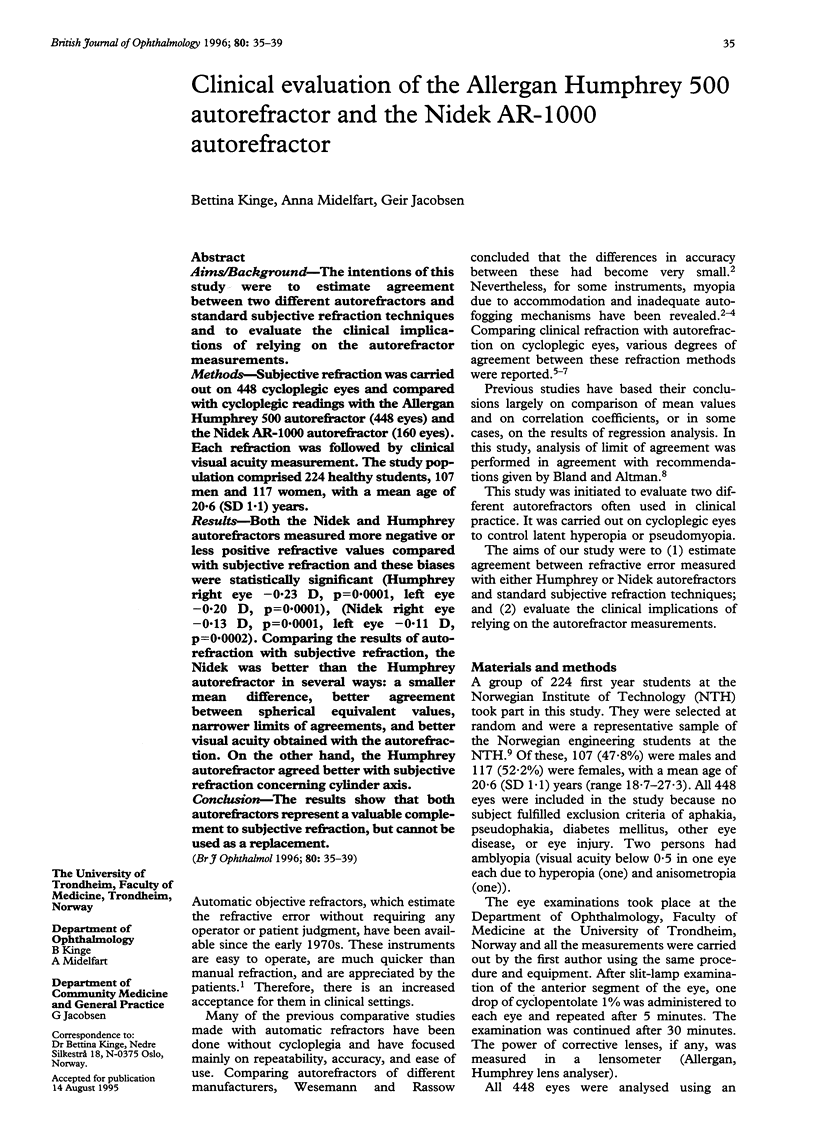
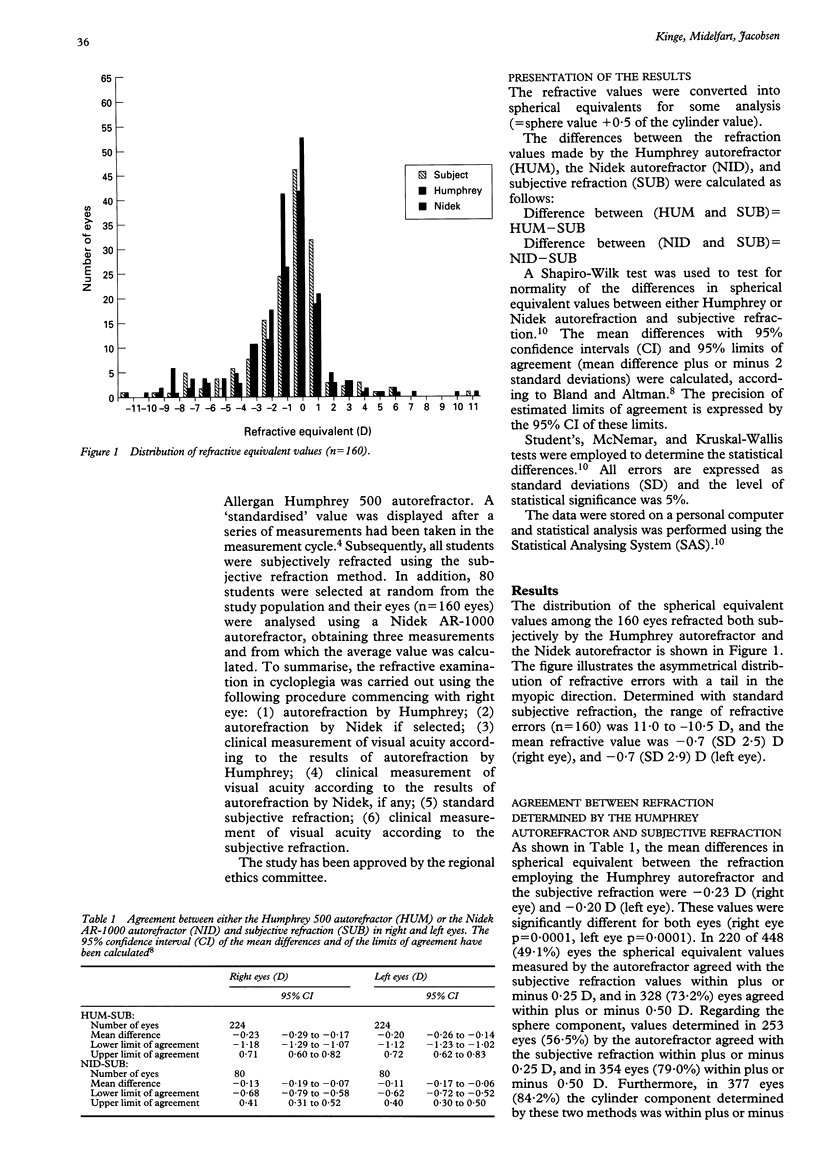
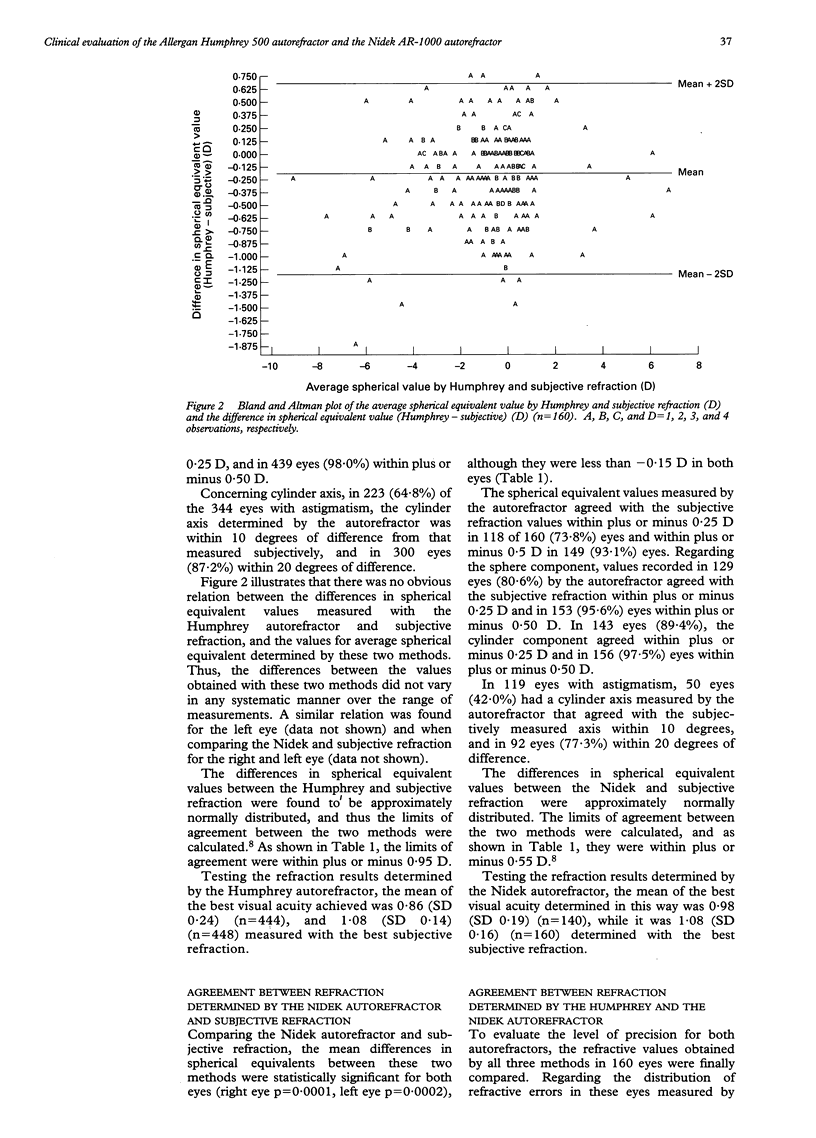
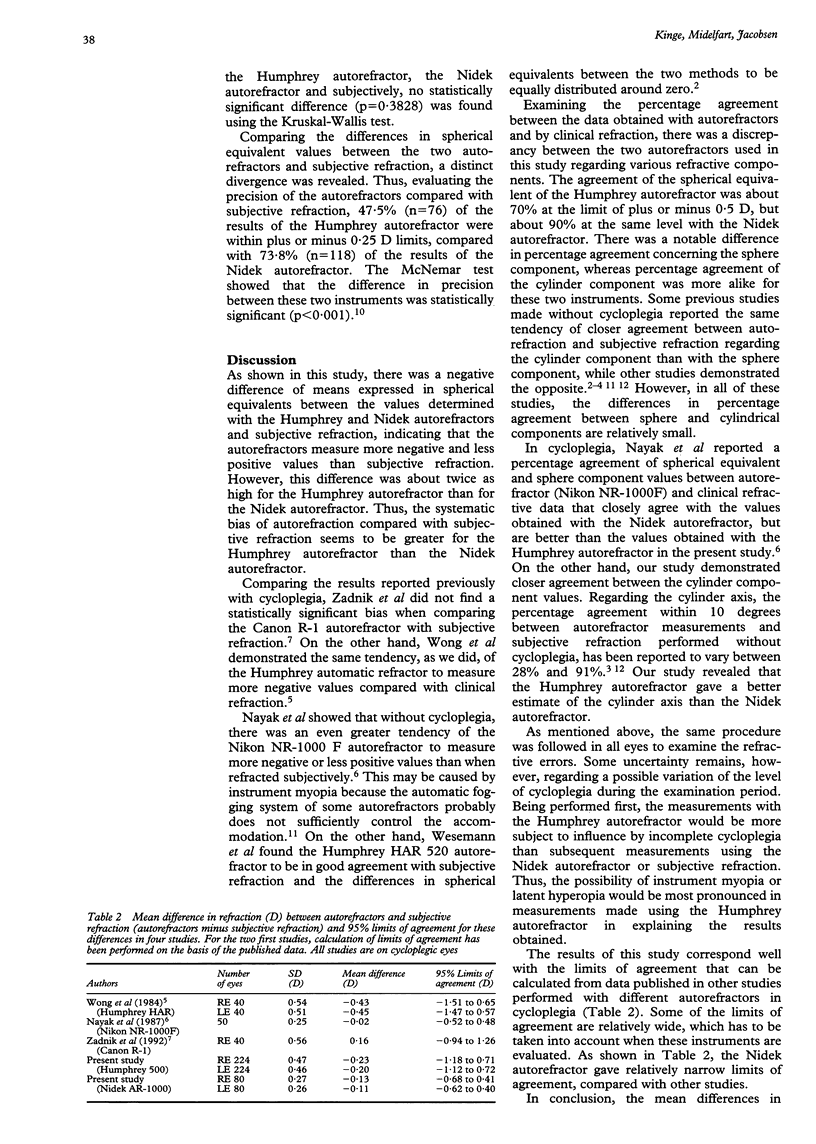
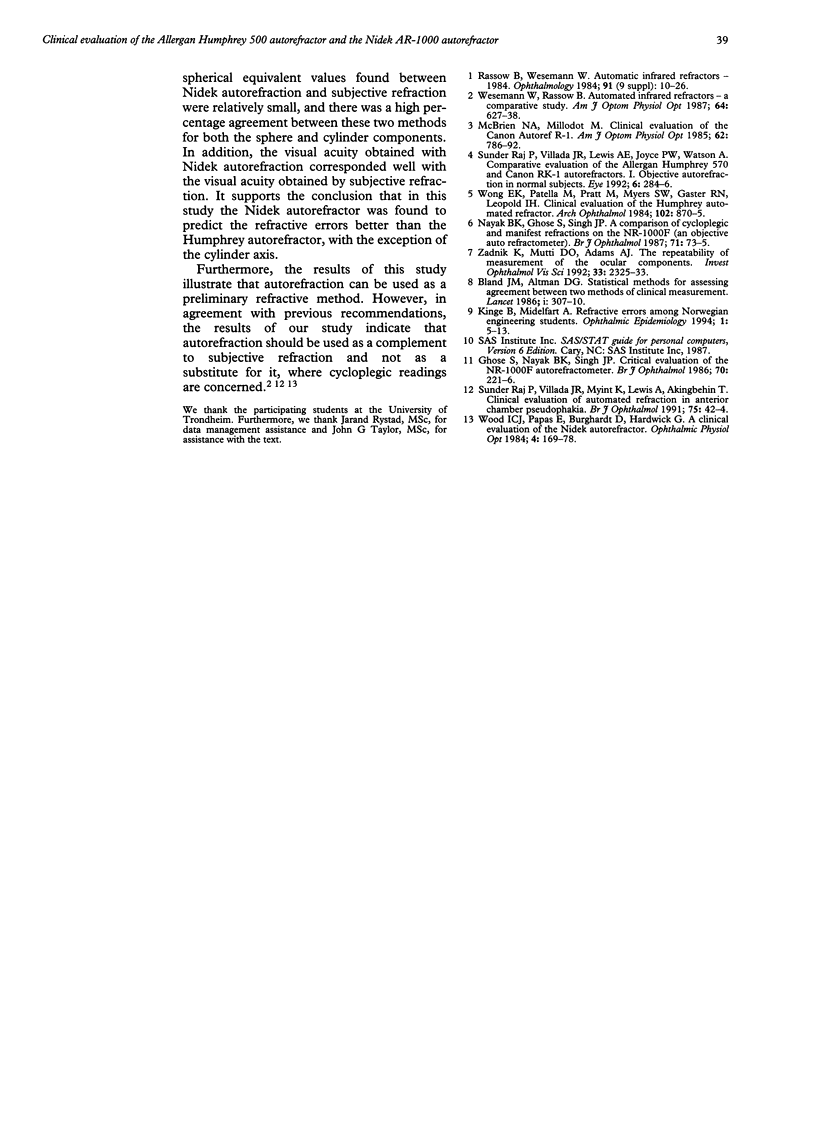
Selected References
These references are in PubMed. This may not be the complete list of references from this article.
- Bland J. M., Altman D. G. Statistical methods for assessing agreement between two methods of clinical measurement. Lancet. 1986 Feb 8;1(8476):307–310. [PubMed] [Google Scholar]
- Ghose S., Nayak B. K., Singh J. P. Critical evaluation of the NR-1000F Auto Refractometer. Br J Ophthalmol. 1986 Mar;70(3):221–226. doi: 10.1136/bjo.70.3.221. [DOI] [PMC free article] [PubMed] [Google Scholar]
- Kinge B., Midelfart A. Refractive errors among engineering students in Norway. Ophthalmic Epidemiol. 1994 Mar;1(1):5–13. doi: 10.3109/09286589409071440. [DOI] [PubMed] [Google Scholar]
- Klein B. E., Davis M. D., Segal P., Long J. A., Harris W. A., Haug G. A., Magli Y. L., Syrjala S. Diabetic retinopathy. Assessment of severity and progression. Ophthalmology. 1984 Jan;91(1):10–17. doi: 10.1016/s0161-6420(84)34374-3. [DOI] [PubMed] [Google Scholar]
- McBrien N. A., Millodot M. Clinical evaluation of the Canon Autoref R-1. Am J Optom Physiol Opt. 1985 Nov;62(11):786–792. doi: 10.1097/00006324-198511000-00011. [DOI] [PubMed] [Google Scholar]
- Nayak B. K., Ghose S., Singh J. P. A comparison of cycloplegic and manifest refractions on the NR-1000F (an objective Auto Refractometer). Br J Ophthalmol. 1987 Jan;71(1):73–75. doi: 10.1136/bjo.71.1.73. [DOI] [PMC free article] [PubMed] [Google Scholar]
- Pollock S. C., Miller N. R. The retinal nerve fiber layer. Int Ophthalmol Clin. 1986 Winter;26(4):201–221. doi: 10.1097/00004397-198602640-00019. [DOI] [PubMed] [Google Scholar]
- Raj P. S., Villada J. R., Lewis A. E., Joyce P. W., Watson A. Comparative evaluation of the Allergan Humphrey 570 and Canon RK-1 autorefractors: I. Objective autorefraction in normal subjects. Eye (Lond) 1992;6(Pt 3):284–286. doi: 10.1038/eye.1992.54. [DOI] [PubMed] [Google Scholar]
- Sunder Raj P., Villada J. R., Myint K., Lewis A. E., Akingbehin T. Clinical evaluation of automated refraction in anterior chamber pseudophakia. Br J Ophthalmol. 1991 Jan;75(1):42–44. doi: 10.1136/bjo.75.1.42. [DOI] [PMC free article] [PubMed] [Google Scholar]
- Wesemann W., Rassow B. Automatic infrared refractors--a comparative study. Am J Optom Physiol Opt. 1987 Aug;64(8):627–638. doi: 10.1097/00006324-198708000-00011. [DOI] [PubMed] [Google Scholar]
- Wong E. K., Jr, Patella V. M., Pratt M. V., Myers S. W., Gaster R. N., Leopold I. H. Clinical evaluation of the Humphrey automatic refractor. Arch Ophthalmol. 1984 Jun;102(6):870–875. doi: 10.1001/archopht.1984.01040030690020. [DOI] [PubMed] [Google Scholar]
- Wood I. C., Papas E., Burghardt D., Hardwick G. A clinical evaluation of the Nidek Autorefractor. Ophthalmic Physiol Opt. 1984;4(2):169–178. [PubMed] [Google Scholar]
- Zadnik K., Mutti D. O., Adams A. J. The repeatability of measurement of the ocular components. Invest Ophthalmol Vis Sci. 1992 Jun;33(7):2325–2333. [PubMed] [Google Scholar]


